Ha Giang tourism entices visitors with its captivating allure and unique beauty that can only be found in Ha Giang. Let’s explore the splendid destinations in Ha Giang!
Ha Giang tourism offers a plethora of fascinating experiences. Ha Giang is not just beautiful due to its majestic landscapes and winding, endless roads, but it also charms with its vibrant flowers and the warmth of its people. Flowers bloom year-round in a variety of enchanting colors: the golden hue of rapeseed flowers, the violet of buckwheat flowers, the pure white of plum blossoms, and a unique blackish-gray flower known as the “Rock Flower” found among the rocky landscapes of the Dong Van Plateau.
- Area: 7,914.9 square kilometers
- Population: 771,200 people (as of 2013)
- Tourist attractions: Ma Pi Leng Pass, Lung Cu Flag Tower, Quan Ba Heaven’s Gate, Dong Van Karst Plateau, Meo King’s Palace, and more.
Table of Contents
Introduction to Ha Giang Tourism
Ha Giang, a northernmost region of Vietnam, shares its border with China and is situated at an elevation of approximately 2,000 meters above sea level. The rugged terrain of Ha Giang features numerous majestic mountainous landscapes with average elevations ranging from 800 to 1,200 meters.
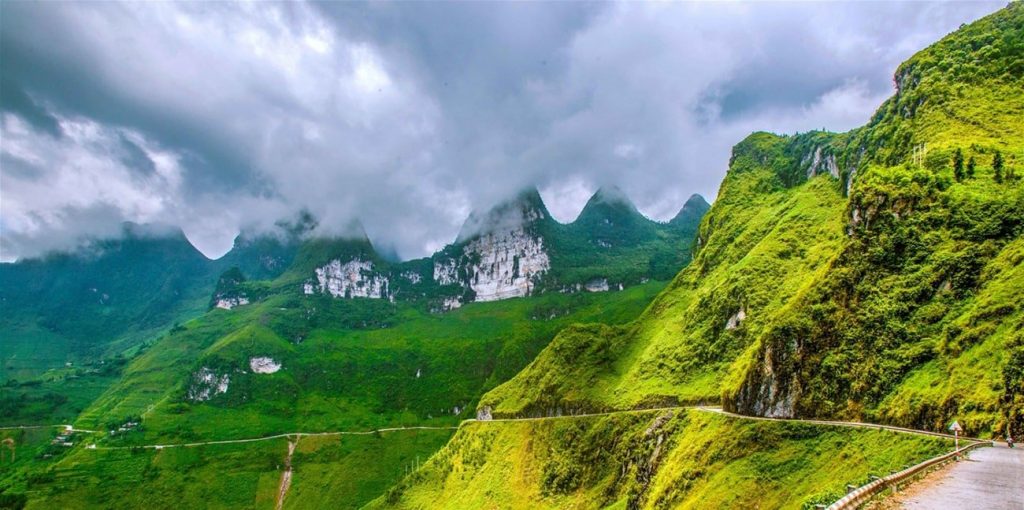
When you embark on a journey to Ha Giang, you’ll not only explore the stunning natural scenery but also delve into the diverse cultures of the various ethnic groups that call this place home. This Northeastern region is also known as the land of flowers, as flowers bloom year-round in an array of enchanting colors.
Geography in Ha Giang
The geography of Ha Giang Province is quite complex and can be divided into three main regions. The northern mountainous area is located near the northern border, featuring steep slopes, valleys, and numerous rivers and streams. Although it falls within a subtropical climate, the high elevation results in a varied temperate climate in Ha Giang. The western highland region consists of the upper Chay River basin, characterized by steep mountains, high passes, narrow valleys, and small streams. The lowland area in the province includes hilly terrain, valleys along the Lo River, and Hà Giang City.
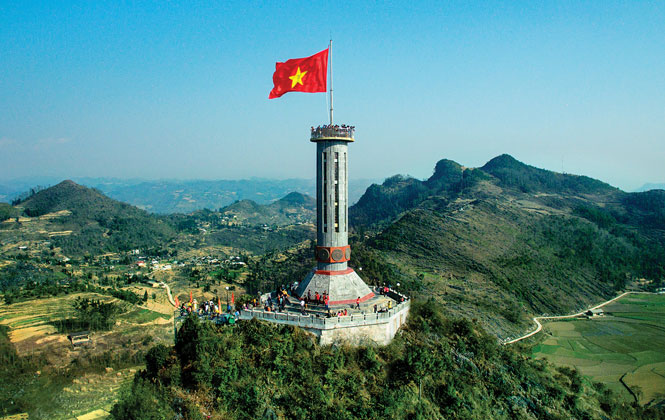
Transportation in Ha Giang
The distance from Hanoi to Ha Giang is approximately 300 kilometers. If you’re adventurous and want to conquer Ha Giang on a motorbike, you can ride your own bike from Hanoi. The travel time can vary from 8 to 10 hours, depending on your speed and the number of people in your group. However, if you’re not enthusiastic about riding from Hanoi to Ha Giang, you can take a sleeper bus to Ha Giang.
Another option that many people choose is to travel to Ha Giang by passenger bus. After taking a sleeper bus from Hanoi to Ha Giang, you can then use various bus routes to reach the highland districts of Quan Ba, Yen Minh, Dong Van, and Meo Vac. Once you arrive at the district centers, you can hire a motorbike taxi (xe ôm) to travel to the tourist attractions. This option is suitable for solo travelers or small groups, especially for those who are not comfortable riding motorbikes in the highland areas.
Alternatively, if you prefer a convenient mode of transportation from Hanoi to Ha Giang, choosing a private travel vehicle with a driver in Ha Noi from DanangPrivateCar.com’s is a great option. This service provides quick and direct pick-up from any location in Hanoi, offers well-equipped and modern vehicles with amenities such as Wi-Fi, and allows for flexibility in stopping at various tourist sites along the way. You can book your private trip from Hanoi to Ha Giang today to have a detailed itinerary arranged for your journey.
Ha Giang’s Scenery by Season
Ha Giang is a mountainous province, so its climate is noticeably cooler compared to lowland areas. The average temperature throughout the year hovers around 21-23°C.
January: The Month of Scenic Spring
Spring brings forth a spectacle of vibrant flowers in the highlands of Ha Giang. In places like Quan Ba, Dong Van, Meo Vac, when you travel to Ha Giang in this month, you can witness the radiant colors of cherry blossoms, plum blossoms, and rapeseed flowers contrasting against the black rocky backdrop of the karst plateau or peeking through the morning sun’s rays, adorning sturdy, traditional houses.
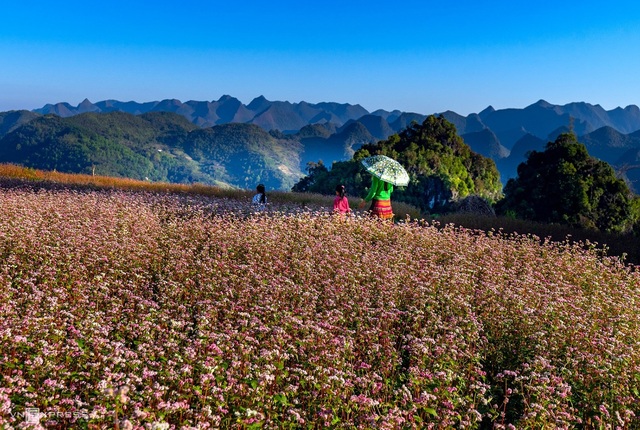
May and June: Flooding Season
The local communities here cultivate only one rice crop per year, which is harvested in September. Around May and early June, heavy rains pour down from the high fields to the lowlands, forming a “waterfall” that stretches from the mountaintops to the foothills. The flooding season lasts until the end of July, but it’s most beautiful during May and June when the planting season begins.
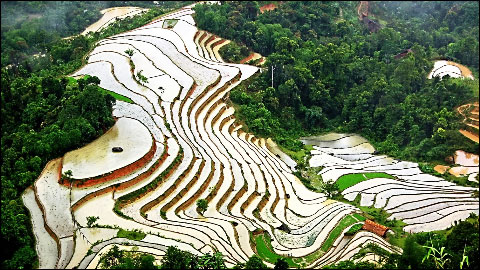
Traveling to Ha Giang during the flooding season allows you to admire picturesque rice terraces like those in Hoang Su Phi, the twin mountains of Quan Ba, or the small rice fields scattered along the joyous Ma Pi Leng Pass.
September: Harvest Season
In September, the rice has started to bloom and is turning a bright, captivating yellow. Witness the vivid and warm shades of yellow, breathe in the scent of ripening rice, and capture stunning photos of the glistening golden fields.
October to December: Buckwheat Flower Season
Delicate buckwheat flowers bloom, displaying a soft pink and purple hue on the hills and mountains of Ha Giang. The magnificent mountainous landscape, coupled with the beauty of buckwheat fields, will surely captivate the hearts of travelers exploring this northernmost region.

Prominent Tourist Attractions in Ha Giang
Ha Giang has long been a fascinating destination for both domestic and international travelers. With picturesque landscapes resembling paintings and majestic rocky mountain scenery, Ha Giang welcomes countless visitors each year. There are numerous captivating places to explore in Ha Giang, and dulichvietnam.com.vn will suggest some of the most outstanding ones below:
Quan Ba Heaven’s Gate and Twin Mountains
Quan Ba Heaven’s Gate, situated 1,500 meters above sea level, marks the entrance to the Dong Van Plateau. In 1939, a monumental wooden gate, measuring 150 cm in thickness, was erected at Heaven’s Gate. Beyond this gate lay another world known as the “Autonomous Region of the H’Mong People,” encompassing the districts of Quan Ba, Meo Vac, Yen Minh, and Dong Van.
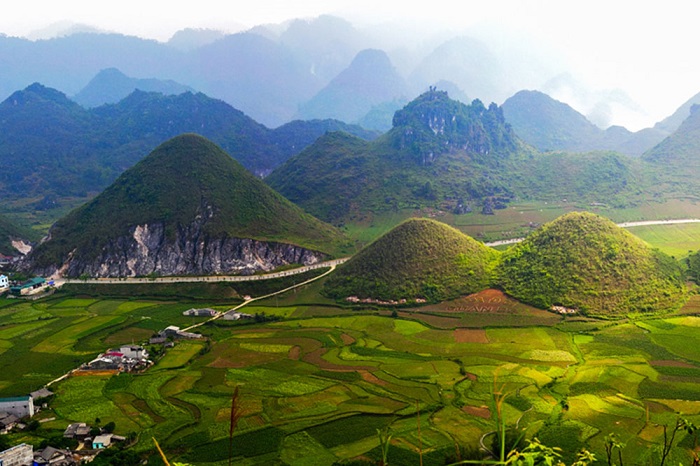
The Twin Mountains of Quan Ba, located alongside National Highway 4C, approximately 40 km from Ha Giang town, rise dramatically between rocky mountains and terraced fields. These peculiar twin peaks, connected to the legend of the Fairy Mountain, leave travelers in awe of the majestic beauty bestowed by nature.
Dong Van Karst Plateau
The Dong Van Karst Plateau, also known as the Dong Van Stone Plateau, spans four districts of Ha Giang Province: Quan Ba, Yen Minh, Dong Van, and Meo Vac. On October 3, 2010, the “Dong Van Karst Plateau Geopark” was officially recognized as a Global Geopark by the UNESCO Global Geoparks Network (GGN). It is currently the only title of its kind in Vietnam and the second in Southeast Asia.
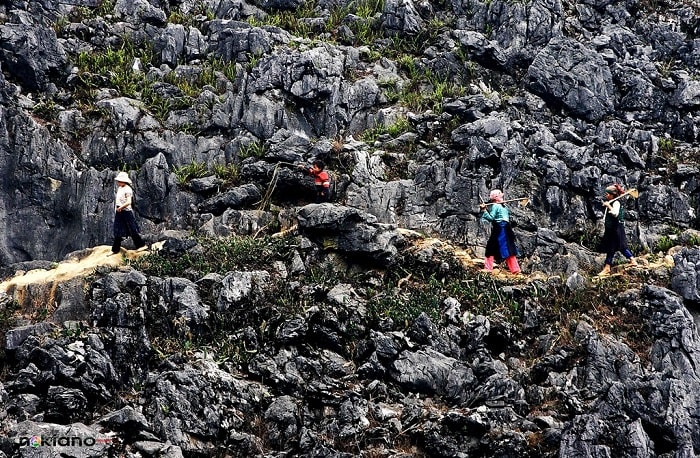
Lung Cu Flag Tower
Lung Cu Flag Tower stands atop Lung Cu Peak, approximately 1,700 meters above sea level, in Lung Cu Commune, Dong Van District, Ha Giang Province. This small landmark is situated on the Vietnam-China border. If you visualize the shape of the Vietnam-China border as a conical hat, then Lung Cu represents the apex of this hat and is the northernmost point of Vietnam.

Meo King’s Palace
After a path lined with towering oak trees, the imposing stone gate of Meo King Vuong Chinh Duc’s palace emerges on a hill in Sa Phin, Dong Van, Ha Giang. Vuong Chinh Duc led the Vuong family, the Hmong ethnic group in Ha Giang, a century ago. Wealthy from cultivating, processing, and trading opium across the borders of China and Myanmar, he dominated this high plateau and proclaimed himself a king.
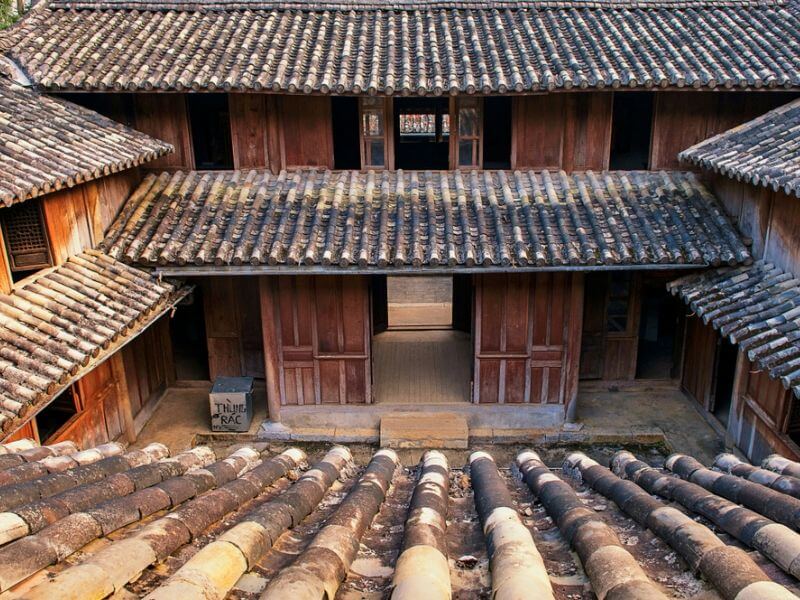
Behind the stone gate is a grand, ancestral palace. The Vuong family’s palace was constructed over eight years at a cost of approximately 150,000 silver coins. Most of the builders were skilled craftsmen from the Van Nam region and the finest groups of Hmong craftsmen.
Ma Pi Leng Pass
Ma Pi Leng, in the Quan Hoa dialect, means “the horse’s nose.” However, in a more figurative sense, this name signifies the highest peril of mountain peaks, where pregnant mares struggle and even die while giving birth, or it can describe steep, lifeless peaks resembling a horse’s nose. Nevertheless, according to some local Hmong people, the correct name for the pass is “Mao Pi Leng,” which means “the cat’s nose.”
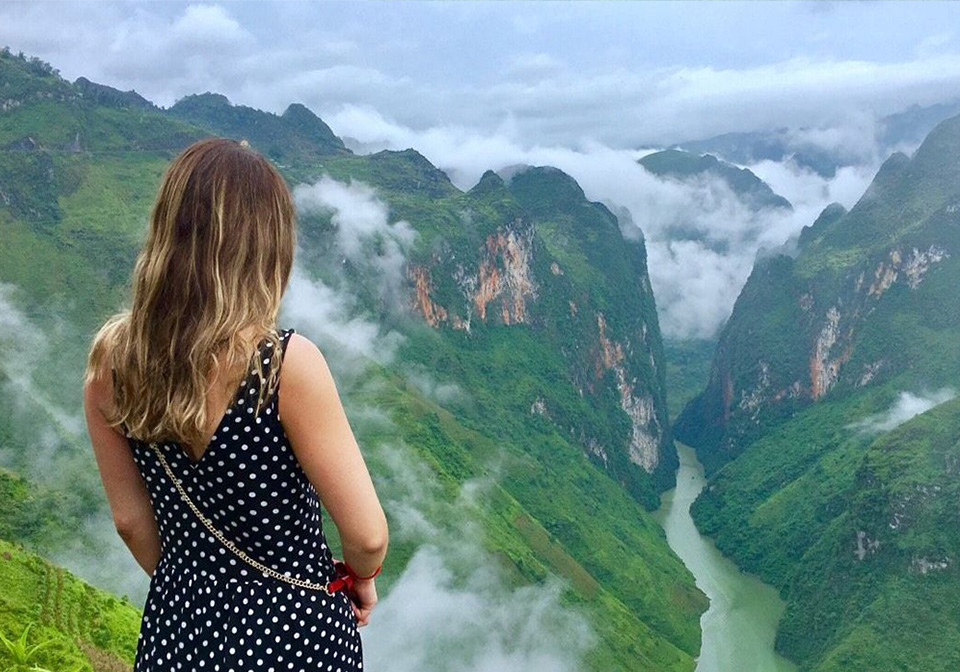
The Ma Pi Leng Pass is situated in three communes: Pai Lung, Pa Vi, and Xin Cai, Meo Vac, Ha Giang. It stands at an elevation of around 2,000 meters above sea level and was formed by a series of sedimentary rocks, including limestone, shale, and silicified limestone, containing fossils dating back around 426 million years. It features numerous faults and fissures resulting from the tectonic activity that created the mountains.
Cuisine in Ha Giang.
Although I’m not a food enthusiast, I do know a few famous dishes in Ha Giang: egg roll, thắng cố, North Me lam rice, Ấu Tẩu porridge (which is special), xôi ngũ sắc, beef and buffalo cooked over the fire, and corn wine (be careful with Ha Giang corn wine; if you don’t know a trusted place, it’s best not to buy it as it’s made with Chinese yeast and can cause headaches).
- Xôi Ngũ Sắc (Five-colored sticky rice): Represents the five elements: metal, wood, water, fire, and earth. Except for the white color, the other colors are achieved by soaking glutinous rice in water infused with various types of leaves and wild plant roots, without the use of artificial coloring agents.
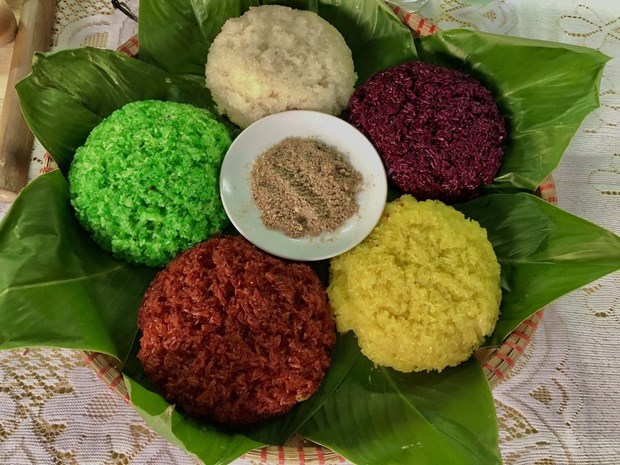
- Cơm Nam Bắc Mê: This is a cherished dish, not only reserved for family meals but also used to treat guests who come to visit.
- Lạp Xưởng Gác Bếp: Made from a type of meat that is half lean and half fat. The meat is trimmed of excess fat, finely minced, then seasoned with spices, white wine, ginger water, and stuffed into casings. Afterward, it is hung near the kitchen fire to imbue the dish with the smoky aroma of the kitchen and the delicate fragrance of wine and spices from the highland region.
In Ha Giang, I had dinner at Trung Lan egg roll shop, right near the city square. This place serves food at night. In Dong Van, you can eat at the Xuân Bằng restaurant. In the morning, you can have egg rolls at the “bà cụ” shop located in the Dong Van Old Quarter.
DanangPrivateCar.com’s has been working with you to introduce Ha Giang tourism, the landscapes of Ha Giang throughout the seasons, and the fascinating experiences when visiting Ha Giang. Get your bags ready and invite your close friends for a trip to Ha Giang. Don’t forget to follow us for more updates on various beautiful travel destinations and resorts across this country of Vietnam.

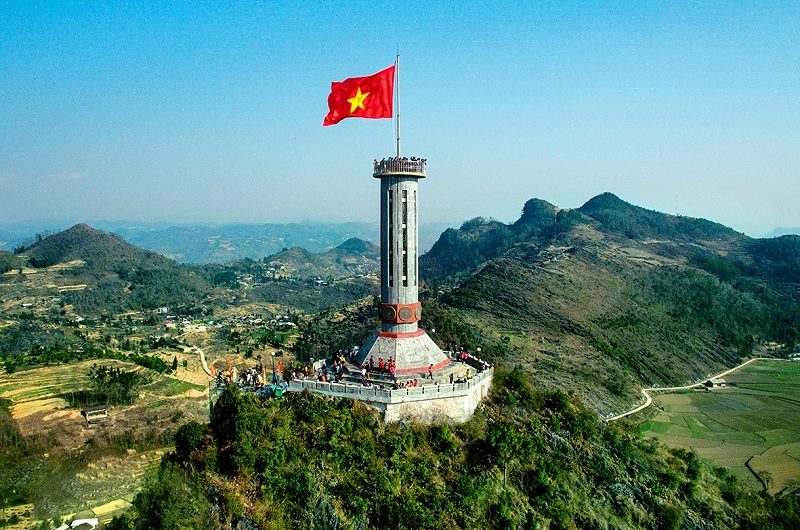
Comments